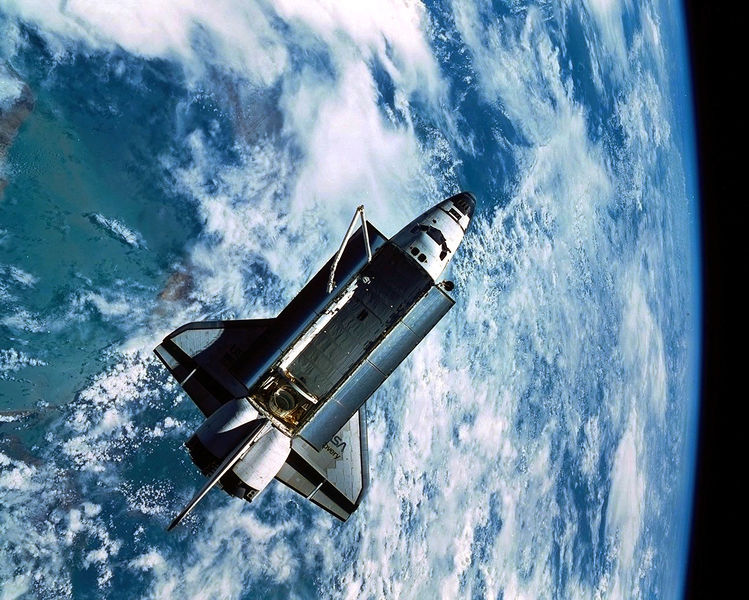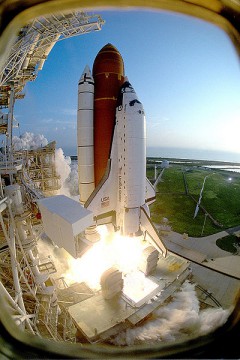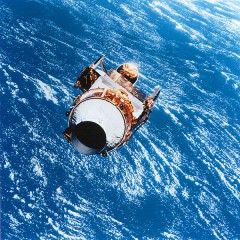
“T-30 seconds … “
The words of the launch commentator at the Kennedy Space Center on the morning of 12 August 1993 were calm and measured, as all eyes focused upon Space Shuttle Discovery as she entered the final portion of the countdown to fly STS-51. The mission—a nine-day flight to deploy a NASA advanced communications satellite and release and retrieve an ultraviolet telescope on a Shuttle Pallet Satellite (SPAS), as well as perform a spacewalk—had already been postponed twice, with the astronauts aboard the vehicle. It was hoped that today would be third time lucky for Commander Frank Culbertson, Pilot Bill Readdy, and Mission Specialists Jim Newman, Dan Bursch, and Carl Walz … but the gremlins of ill-fortune still had one more card to play.
So far, everything had gone well. The five men had closed and locked their visors and their eyes were focused intently on their instruments. At T-5 minutes, Readdy switched on Discovery’s Auxiliary Power Units (APUs), bringing life, muscle, and control to the hydraulic systems. The clock continued counting. At T-31 seconds, command of the countdown and all vehicle critical functions were handed off to the shuttle’s on-board computers.
“T-10, 9, 8, 7 … Go for Main Engine Start … “
Inside the cabin, the astronauts felt the immense vibration as turbopumps awoke, liquid oxygen and hydrogen flooded into the combustion chambers of Discovery’s main engines, and they roared to life … and, all at once, were automatically shut down. The roar was replaced first by an ethereal silence and then by the blaring of the master alarm.
” … We have a Main Engine Cutoff. Safing in work … “
The communications loop from the Launch Control Center provided a flurry of messages, verifying that the three main engines were in post-shutdown standby and requesting Readdy to shut down the three APUs. No fire detectors on Pad 39B had tripped during the incident, which would later be traced to a faulty fuel-flow sensor in the No. 2 main engine. The engine had posted a “major component failure,” caused by the sensor glitch, about 0.6 seconds after ignition. “This condition,” noted NASA’s official STS-51 Mission Report, “caused a miscompare which violated the Launch Commit Criteria … As a result of the failure, the engines were shut down and safing activities were initiated.”

Shortly thereafter, the five astronauts disembarked from Discovery, aware from previous Redundant Set Launch Sequencer (RSLS) aborts that their launch had been called off for several weeks at best. The main engines were replaced and an attempt was provisionally scheduled for 10 September, but this was itself slipped by two days, as a result of the failure on 21 August of NASA’s Mars Observer, shortly before its arrival at the Red Planet. During the early investigation into the loss of Mars Observer, it was revealed that the spacecraft’s Transfer Orbit Stage (TOS)—a near-identical booster to that of STS-51’s primary payload, the $363 million Advanced Communications Technology Satellite (ACTS)—had exhibited a transistor failure. During the additional two days’ delay, engineers and managers verified that there was no commonality between the Mars Observer fault and ACTS.
Liftoff of the long-delayed mission finally took place at 7:45 a.m. EDT on the 12th, and a nominal ascent placed Discovery into the intended orbit. Years later, Jim Newman recalled his first experience of flying in space. “When we first got to orbit, it was exhilarating,” he told a NASA interviewer. “I can remember getting out of my seat and going to the windows in the aft flight deck. The orbiter was upside-down, so that we were able to look and see the Earth, ‘beneath’ us. If you’ve ever seen the IMAX movies, they almost capture it all, but to be floating—to be seeing the Earth with my own eyes—was really spectacular!”
Within two hours, the payload bay doors were open, exposing STS-51’s twin-satellite cargo space environment for the first time. At the rear end of the bay, the ACTS-TOS combination represented one of the most advanced communications satellites ever inserted into orbit. ACTS’ purpose was to serve as a testbed for the development of high-risk advanced communications satellite technologies, employing sophisticated antenna beams and on-board switching and processing systems and bringing together government, academia, and industry. Specifically, the satellite operated across three channels within the 30/20 GHz Ka-band, which boasted 2.5 GHz of available spectrum—some five times that available at lower-frequency bands—and very high-gain, multiple-hopping beam antennas which permitted smaller-aperture Earth stations.
Attached to the base of ACTS was the TOS booster, making its second flight after Mars Observer and its first and only flight aboard the shuttle. On STS-51, the TOS was tasked with delivering the payload into an elliptical geosynchronous transfer orbit. In readiness for the release of the payload, Discovery’s aft flight deck was a hive of activity on the first day of the mission, with deployment anticipated eight hours after launch, at 3:43 p.m. EDT, on the sixth orbit. The astronauts checked out the TOS’ critical systems and unlatched and rotated the upper forward cradle into its “open” configuration, after which the entire payload was elevated to an angle of 42 degrees.

However, deployment was postponed by another orbit, lasting 90 minutes, when orbiter S-band forward-link communications with Mission Control were lost. Flight controllers could receive telemetry and voice communications from Discovery, but not vice-versa. The astronauts followed their malfunction protocols, waved off the planned deployment, and changed the S-band to a lower frequency. This restored communications after 45 minutes. Deployment finally took place at 5:13 p.m. EDT, about 9.5 hours into the mission. Under the direction of Walz and Newman, a “Super*Zip” separation mechanism was fired and springs on the aft cradle of the TOS pushed the payload away from the shuttle.
It later became clear from video footage that extensive damage had been caused to the expanding tube assembly and doublers on the Super*Zip ring. Debris included sharp-edged metal and other non-metallic materials, and well over half of the expanding tube assembly was recorded as being “no longer restrained to the airborne support equipment.” Investigations revealed that the primary and backup separation “cords” of the Super*Zip ring were fired simultaneously and, despite concern about potential damage to the orbiter, it was determined that the payload bay liners and thermal blankets could sustain impacts from the expanding tube assembly fragments if they came loose during re-entry.
In mid-October 1993, an investigative board was established by Jeremiah Pearson, NASA’s associate administrator for space flight, to identify the cause of the Super*Zip incident. The board found a total of 36 debris hits in Discovery’s mid-body and aft bulkhead areas, resulting in tears, gouges, scratches, and the deposition of residue on several surfaces. One area of penetration passed through the aft bulkhead itself. “None of the debris hits had any effect during the flight,” noted NASA’s post-flight summary, “and all damage sites will be repaired during turnaround operations.”
With the deployment of ACTS behind them, the STS-51 astronauts pressed on with the remainder of their mission, which, although scheduled for nine days, was expected to be extended to a “highly desirable” 10 days. The crew’s second major payload was the German-built Shuttle Pallet Satellite, which had flown on two previous missions, but which was being carried for the first time in its new “ASTRO-SPAS” configuration. Unlike its first-generation predecessor, ASTRO-SPAS had the capability to remain in autonomous free-flight for up to 10 days, commanded by the mobile German SPAS Payload Operations Centre (SPOC). The power for the satellite and its payloads came from a new lithium-sulphate battery pack and precise attitude-control was provided by a three-axis-stabilised cold-gas system, a star tracker, and a space-borne global-positioning system (GPS) receiver.
The satellite’s precise attitude-control capabilities enabled it to support sensitive astronomical and Earth-observation sensors, with several missions planned. Two of these would carry a set of infrared telescopes and spectrometers to examine the upper atmosphere, one was scheduled (but never flown) to demonstrate advanced automated rendezvous and capture technologies in support of Space Station Freedom, and two others—including the ASTRO-SPAS aboard STS-51—carried the Orbiting and Retrievable Far and Extreme Ultraviolet Spectrometer (ORFEUS). This instrument, with a large telescope, was designed to investigate very hot and very cold matter in the universe, combined with an Interstellar Medium Absorption Profile Spectrograph (IMAPS). Also affixed to the ASTRO-SPAS framework was a surface effects sample monitor to evaluate several future telescope material samples and a remote IMAX camera.
As the mission progressed, not only would the STS-51 astronauts successfully deploy and retrieve ORFEUS, but they would also support an ambitious spacewalk, during which Walz and Newman supported preparations for the daunting repair of the Hubble Space Telescope. In so doing, Frank Culbertson’s crew established their mission as one which demonstrated virtually all of the shuttle’s myriad capabilities. And it demonstrated them in style.
The second part of this article will appear tomorrow.
Want to keep up-to-date with all things space? Be sure to “Like” AmericaSpace on Facebook and follow us on Twitter: @AmericaSpace



